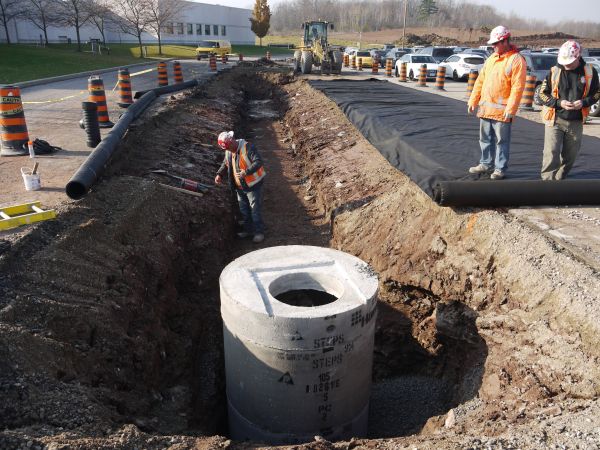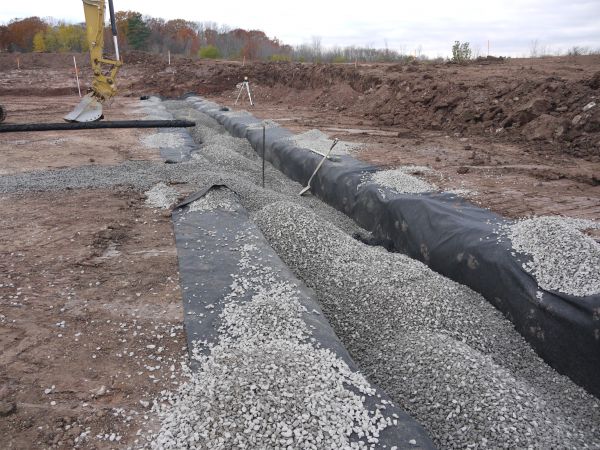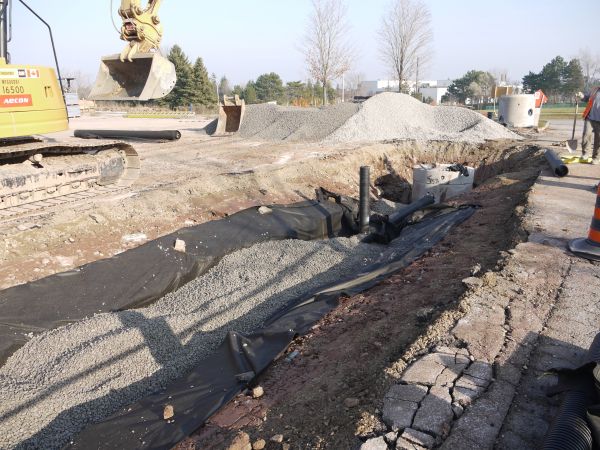Difference between revisions of "Geotextiles: Installation"
Jump to navigation
Jump to search
JamesCowan (talk | contribs) |
JamesCowan (talk | contribs) |
||
| (11 intermediate revisions by 3 users not shown) | |||
| Line 1: | Line 1: | ||
[[Geotextiles]] are filter fabrics that can be installed to separate dissimilar soils and prevent the migration of materials. Geotextiles are recommended for installation at the bottom and side limits of the LID feature and should be implemented at the discretion of the engineer. | [[Geotextiles]] are filter fabrics that can be installed to separate dissimilar soils and prevent the migration of materials. Geotextiles are recommended for installation at the bottom and side limits of the LID feature and should be implemented at the discretion of the engineer. | ||
Construction Steps: | '''Construction Steps:''' | ||
#Roll out fabric on the flattened sub-grade surface | #Roll out fabric on the flattened sub-grade surface. | ||
#Provide a minimum overlap of 300 mm between adjacent lengths of geotextile. If the manufacturer specifies a greater overlap, follow the manufacturer’s specification | #Provide a minimum overlap of 300 mm between adjacent lengths of geotextile. If the manufacturer specifies a greater overlap, follow the manufacturer’s specification. | ||
#Secure fabric in place with stakes along the edge of the sub-grade surface and where lengths of fabric overlap | #Secure fabric in place with stakes along the edge of the sub-grade surface and where lengths of fabric overlap. | ||
#Provide 500 mm of excess at the ends of each length of fabric. Fold excess materiel on top of the infiltration medium/choker course once installed | #Provide 500 mm of excess at the ends of each length of fabric. Fold excess materiel on top of the infiltration medium/choker course once installed. | ||
#Provide cuts for trees and shrubs where appropriate | #Provide cuts for trees and shrubs where appropriate. | ||
#Assess on-site conditions to ensure that the tensile, tear, and puncture strength ratings of the geotextile are suitable for expected structural loads (e.g. traffic). If not properly considered, geotextiles can be adversely impacted by loading from adjacent infrastructure uses | #Assess on-site conditions to ensure that the tensile, tear, and puncture strength ratings of the geotextile are suitable for expected structural loads (e.g. traffic). If not properly considered, geotextiles can be adversely impacted by loading from adjacent infrastructure uses. | ||
Key Inspection Points: | '''Key Inspection Points:''' | ||
*Geotextile is clean and free of damage | *Geotextile is clean and free of damage. | ||
*Geotextile delivered to the site matches the design specifications and is approved by the engineer prior to installation | *Geotextile delivered to the site matches the design specifications and is approved by the engineer prior to installation. | ||
*Sufficient overlap is provided between lengths of fabric | *Sufficient overlap is provided between lengths of fabric. | ||
*Geotextiles have been applied as per the manufacturer’s guidelines | *Geotextiles have been applied as per the manufacturer’s guidelines. | ||
*Structural considerations for geotextiles have been made when applied adjacent to infrastructure and the geotextile can handle expected structural loads | *Structural considerations for geotextiles have been made when applied adjacent to infrastructure and the geotextile can handle expected structural loads. | ||
*Class II geotextiles conform to OPSS 1860 | *Class II geotextiles conform to OPSS 1860. | ||
Mistakes to Avoid: | '''Mistakes to Avoid:''' | ||
*Wrinkles in the fabric | *Wrinkles in the fabric: Follow the manufacturer’s procedure for installation to ensure geotextiles lie smooth on sub-grade. | ||
*Unnecessary application of geotextile | *Unnecessary application of geotextile: Mixing of media is negligible where structural loads are not expected, so geotextile does not need to be applied. Also, geotextiles should not be used where root growth is encouraged to penetrate different layers of media. | ||
<gallery mode="packed" widths=300px heights=300px> | <gallery mode="packed" widths=300px heights=300px> | ||
geotextile-facility-side.jpg | The shape of the LID feature required the geotextile to be rolled out prior to being laid on the subgrade surface. | geotextile-facility-side.jpg | The shape of the LID feature required the geotextile to be rolled out prior to being laid on the subgrade surface. Photo taken during construction of IMAX Corporation Headquarters. (Photo Source: CVC, 2012) | ||
geotextile-with-excess-and-granular.jpg | Excess fabric is draped over the edges of the LID practice, and backfilling with granular is taking place. | geotextile-with-excess-and-granular.jpg | Excess fabric is draped over the edges of the LID practice, and backfilling with granular is taking place. Photo taken during construction of IMAX Corporation Headquarters. (Photo Source: CVC, 2012) | ||
geotextile-backfill-underdrain.jpg | Footprint with geotextile, granular, and underdrain. | geotextile-backfill-underdrain.jpg | Footprint with geotextile, granular, and underdrain. Photo taken during construction of IMAX Corporation Headquarters. (Photo Source: CVC, 2012) | ||
</gallery> | </gallery> | ||
[[Category:Gallery]] | [[Category:Gallery]] | ||
Latest revision as of 01:17, 29 September 2022
Geotextiles are filter fabrics that can be installed to separate dissimilar soils and prevent the migration of materials. Geotextiles are recommended for installation at the bottom and side limits of the LID feature and should be implemented at the discretion of the engineer.
Construction Steps:
- Roll out fabric on the flattened sub-grade surface.
- Provide a minimum overlap of 300 mm between adjacent lengths of geotextile. If the manufacturer specifies a greater overlap, follow the manufacturer’s specification.
- Secure fabric in place with stakes along the edge of the sub-grade surface and where lengths of fabric overlap.
- Provide 500 mm of excess at the ends of each length of fabric. Fold excess materiel on top of the infiltration medium/choker course once installed.
- Provide cuts for trees and shrubs where appropriate.
- Assess on-site conditions to ensure that the tensile, tear, and puncture strength ratings of the geotextile are suitable for expected structural loads (e.g. traffic). If not properly considered, geotextiles can be adversely impacted by loading from adjacent infrastructure uses.
Key Inspection Points:
- Geotextile is clean and free of damage.
- Geotextile delivered to the site matches the design specifications and is approved by the engineer prior to installation.
- Sufficient overlap is provided between lengths of fabric.
- Geotextiles have been applied as per the manufacturer’s guidelines.
- Structural considerations for geotextiles have been made when applied adjacent to infrastructure and the geotextile can handle expected structural loads.
- Class II geotextiles conform to OPSS 1860.
Mistakes to Avoid:
- Wrinkles in the fabric: Follow the manufacturer’s procedure for installation to ensure geotextiles lie smooth on sub-grade.
- Unnecessary application of geotextile: Mixing of media is negligible where structural loads are not expected, so geotextile does not need to be applied. Also, geotextiles should not be used where root growth is encouraged to penetrate different layers of media.


